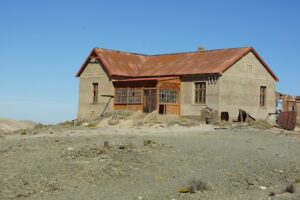Housing Investment Landscapes Namibia January 2019
Introduction:
This country report forms part of The Centre for Affordable Housing Finance’s Investor Programme which aims to reduce key information asymmetries on who, why and how investments are made in the African housing sector. With the intention of identifying and championing increased investment in affordable housing, the report includes insights into and analysis of the depth and breadth of investment in Namibia’s housing and housing finance sector. The overall goal of this project is to quantify investment activity in housing and housing finance across Africa, and to establish a mechanism to track this on an ongoing basis.
This project has collected data and highlights gaps and opportunities in the investment landscape. To stimulate greater investment in affordable housing and connect investors with potential investments, the report profiles investors and investment instruments with the greatest impact on the housing finance market within the Southern Africa Development Community (SADC). Growing financial sector experience and increasingly sophisticated financial instruments are driving Investor interest in African real estate. This includes new market opportunities related to a rising urban middle class, an increasingly localised construction material industry and innovations in housing finance such the emergence of Real Estate Investment Trusts (REITs) and mortgage liquidity facilities across Africa. However, a chronic lack of rigorous data on financial infrastructure investment presents a key barrier to this growth.
Local institutional investors:
Capital markets:
The Namibian Stock Exchange (NSX) lists 40 companies and four exchange traded funds. These companies are predominantly in the mining or banking sectors, with many of the listings being secondary listings, often for South African firms. The listed banks are FirstRand, Nedbank, Investec, and Standard Bank. Except for Investec, these are the leading players in the Namibian mortgage market, alongside Bank Windhoek (whose largest shareholder, Capricorn Investment Group, is listed). More detail on the mortgage market is given in later sections.
Pension Funds:
Pension funds play a significant role in the Namibian financial sector, providing crucial long-term financing to the economy through direct and indirect investments in domestic businesses. The sector consists of 91 pension funds, with a combined N$137.5 billion (USD11.7 billion) of assets, representing 86 percent of GDP. More than 50 percent of pension fund assets is invested in equities. The Government Institutions Pension Fund (GIPF) is the country’s largest pension fund and largest single consolidated investment entity. Its total assets exceeded N$106 billion (USD9 billion) in 2017, and in 2014 it represented 71 percent of all assets under management in Namibia.
DFI Investment:
Most DFI investment has been aimed at supporting the financial sector and lending to SMEs, but not specifically aimed at the housing sector. The main foreign investments in the housing sector have been a N$1 billion (USD85 million) loan from the African Development Bank to DBN, USD 120 million from the IFC to support the financial sector through Bank Windhoek and Trustco Group Holdings, as well as DFI investments of USD 20 million each from the UK and Germany.
Private Equity:
Compared to other sub-Saharan countries, Namibia is a frequent recipient of private equity funds as it has the requisite macroeconomic policy and regulatory framework, as well as functioning capital markets. New regulations introduced in 2015 mandated that pension funds must invest a minimum of 1.75 percent of their market values domestically inzato unlisted investments, with a maximum investment of 3.5 per cent, thereby encouraging private equity activity.
Investment in Housing:
This section analyses investment levels and different investment tools targeting the housing and housing finance sector in Namibia. Despite increased political willingness to diminish the housing shortage, there has not been a substantial degree of wholesale funding to the housebuilding sector. In 2013, the State-owned National Housing Enterprise (NHE) estimated the cost of closing the 100 000 housing-unit backlog by 2030 at N$45 billion (US$3.8 billion), 37 percent of 2016 GDP. This backlog has subsequently increased so this is likely a low estimate. Given the government’s self-imposed 35 percent public debt-to-GDP limit, it is clear that NHE will require significant private sector assistance, in particular as public debt totaled 46.9 percent of GDP in 2017.
The Breadth and Depth of Housing and Housing Finance Products:
In 2017, 81 percent of Namibians aged over 15 held a bank account, 18 one of the highest figures in the continent and well above the SADC average of 50 percent. Nine percent of the population aged above 15 have an outstanding home loan (SADC – 5.7 percent), rising to 13 percent when just looking at the male population (SADC – 7 percent). These figures, in addition to a relatively large mortgage market, suggest that the housing finance sector is much more developed than many of its SADC peers. Many Namibians also have a large reliance on remittances, with 53 percent of the population having received domestic remittances in 2017, higher than any other SADC country. Affordability remains an issue. According to FinMark Trust, 70 percent of the Namibian population cannot access collateralised home loan facilities.

Conclusion:
The existing model for the provision of housing has so far failed to supply an adequate amount of low cost affordable housing. Certain regulations, such as maximum density and minimum parking requirements per unit, have increased the cost per square metre of a building, and led to an exit of property developers from the low-cost market. A re-evaluation of the regulatory requirements could increase the returns to low-cost construction and encourage more private sector participants to enter the market. Also, facilitating lower income consumers’ access to credit and ease of registration should stimulate the demand side, further encouraging property developers to target this end of the market. The role of NHE will also be key, as its ambitious housebuilding plans will require significant private sector funding.
Also Read: Housing Finance Strategy for Bulgaria Working Paper
